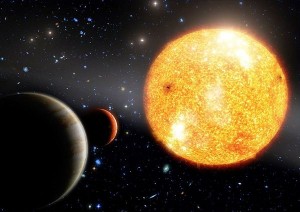Two huge planets found orbiting a star 375 light-years away are the oldest alien worlds yet discovered, scientists say.
With an estimated age of 12.8 billion years, the host star—and thus the planets—most likely formed at the dawn of the universe, less than a billion years after the big bang.
“The Milky Way itself was not completely formed yet,” said study leader Johny Setiawan, who conducted the research while at the Max-Planck Institute for Astronomy in Heidelberg, Germany.
(Related: “Oldest Material in Solar System Found.”)
During a recent survey, Setiawan and colleagues found the signatures of the two planets orbiting the star, dubbed HIP 11952.
Based on the team’s calculations, one world is almost as massive as Jupiter and completes an orbit in roughly seven days. The other planet is nearly three times Jupiter’s mass and has an orbital period of nine and a half months.
It’s possible the planets are much younger than they seem if the worlds formed long after their star was born—but such a scenario is unlikely, the team says.
“Usually planets form just shortly after the star formation,” Setiawan said. “Second-generation planets might also form after a star has died, but this is still under debate.”
Ancient Planets Defy Theory
Setiawan and colleagues found the ancient planets using a technique called radial velocity, in which astronomers watch for periodic wobbles in a star’s light due to the gravitational tugs of orbiting worlds.
The discovery indicates that planet formation in the early universe was possible despite the fact that stars in existence back then were metal-poor—the astronomy term for stars lacking in elements heavier than hydrogen and helium.
In the case of HIP 11952, “its iron abundance is only about one percent that of our sun,” Setiawan said.
The idea of planets springing from such a stellar makeup runs counter to a widely accepted theory called the accretion model, which says that heavy elements are needed to form planets.
Even gas giants like Saturn and Jupiter require heavy elements to take shape, the thinking goes, because they are built upon solid cores. (Related: “New Model of Jupiter’s Core Ignites Planet Birth Debate.”)
The accretion theory has so far been backed up by observations: Most of the planet-harboring stars discovered to date are relatively young and have moderate to high amounts of metals.
But there may be an observational bias, Setiawan said: Astronomers may think the accretion model is correct because planet hunters have been targeting mostly young, sunlike stars.
“To verify this issue, it is necessary to do a planet-search survey around [older] metal-poor stars,” Setiawan said.
(Also see “New ‘Super Earth’ Found at Right Distance for Life.”)
Clock Ticking for Oldest Worlds
Despite the newfound planets’ longevity, it’s unlikely the worlds will survive for another 13 billion years.
The parent star will soon transform into a red giant, Setiawan said, one of the last stages of a sunlike star’s life. (Related: “New ‘Deep Fried’ Planets Found—Survivors of Star Death.”)
During this stage, the star will swell in size and most likely engulf any nearby planets.


This is my term paper topic. I bet there are billions more planets like this!